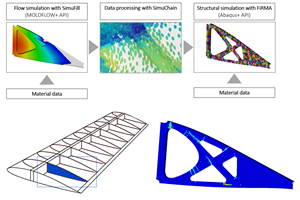High-volume molding methods
Compression molding is a high-volume thermoset molding process that employs expensive but very durable metal dies. It is an appropriate choice when production quantities exceed 10,000 parts. As many as 200,000 parts can be turned out on a set of forged steel dies, using sheet molding compound (SMC), a composite sheet
Compression molding is a high-volume thermoset molding process that employs expensive but very durable metal dies. It is an appropriate choice when production quantities exceed 10,000 parts. As many as 200,000 parts can be turned out on a set of forged steel dies, using sheet molding compound (SMC), a composite sheet material made by sandwiching chopped fiberglass between two layers of thick resin paste. To form the sheet, the resin paste transfers from a metering device onto a moving film carrier. Chopped glass fibers drop onto the paste, and a second film carrier places another layer of resin on top of the glass. Rollers compact the sheet to saturate the glass with resin and squeeze out entrapped air. The resin paste initially is the consistency of molasses (between 20,000 and 40,000 cps); over the next three to five days, its viscosity increases and the sheet becomes leather-like (about 25 million cps), ideal for molding.
When the SMC is ready for molding, it is cut into smaller sheets and the charge pattern (ply schedule) is assembled on a heated mold (121┬░C to 262┬░C or 250┬░F to 325┬░F). The mold is closed and clamped, and pressure is applied at 24.5 bar to 172.4 bar (500 psi to 2,500 psi). Material viscosity drops and the SMC flows to fill the mold cavity. After cure, the part is demolded manually or by integral ejector pins.
A typical low-profile (less than 0.05 percent shrinkage) SMC formulation for a Class A finish consists, by weight, of 25 percent polyester resin, 25 percent chopped glass, 45 percent fillers and 5 percent additives. Fiberglass thermoset SMC cures in 30 to 150 seconds and overall cycle time can be as low as 60 seconds. Other grades of SMC include low-density, flexible and pigmented formulations. Low-pressure SMC formulations now on the market offer open molders a low-capital investment entry into closed mold processing with near-zero VOC emissions and the potential for very high-quality surface finish.
Automakers are exploring carbon fiber-reinforced SMC, hoping to take advantage of carbon's high strength and stiffness-to-weight ratio in exterior body panels and other parts. Newer, toughened SMC formulations help prevent microcracking, a phenomenon that can lead to paint "pops"during the painting process (surface craters caused by outgassing, the release of gasses trapped in the microcracks during oven cure).
Composites manufacturers in industrial markets are formulating their own resins and compounding SMC in-house to meet needs in specific applications that require UV, impact and moisture resistance, and have surface-quality demands that drive the need for customized material development.
Injection molding is a fast, high-volume, low-pressure, closed process using, most commonly, filled thermoplastics, such as nylon with chopped glass fiber. In the past 20 years, however, automated injection molding of BMC has taken over some markets previously held by thermoplastic and metal casting manufacturers. For example, the first-ever BMC-based electronic throttle control (ETC) valves (previously molded only from die-cast aluminum) debuted on engines in BMW's Mini and the Peugeot 207, taking advantage of dimensional stability offered by a specially-formulated BMC supplied by TetraDUR GmbH (Hamburg, Germany), a subsidiary of Bulk Molding Compounds Inc. (BMCI, West Chicago, Ill.).
In the injection molding process, a ram- or screw-type plunger forces a metered shot through a heated barrel and injects it (at 5,000 to 12,000 psi) into a closed, heated mold. In the mold, the liquefied BMC flows easily along runner channels and into the closed mold. After cure and ejection, parts need only minimal finishing. Injection speeds are typically one to five seconds, and as many as 2,000 small parts can be produced per hour in some multiple-cavity molds.
Parts with thick cross-sections can be compression-molded or transfer-molded with BMC. Transfer molding is a closed-mold process wherein a measured charge of BMC is placed in a pot with runners leading to the mold cavities. A plunger forces the material into the cavities, where the product cures under heat and pressure.
Filament winding is a continuous fabrication method that can be highly automated and repeatable with relatively low material costs. A long, cylindrical tool called a mandrel is suspended horizontally between end supports, while the "head"- the fiber application instrument - moves back and forth along the length of a rotating mandrel, placing fiber onto the tool in a predetermined configuration. Computer-controlled filament-winding machines are available, equipped with from 2 to 12 axes of motion.
In most thermoset applications, the filament winding apparatus passes the fiber material through a resin "bath,"just before the material touches the mandrel. This is called "wet winding."Towpreg, that is, continuous fiber pre-impregnated with resin, also be wound, eliminating the need for an onsite resin bath. In a slightly different process, fiber is wound without resin ("dry winding├óŌé¼┬Ø). The dry shape is then removed and used as a preform in another molding process, such as RTM.
Following oven or autoclave curing, the mandrel may remain in place and become part of the wound component or it may be removed. One-piece cylindrical or tapered mandrels, usually of simple shape, are pulled out of the part with mandrel extraction equipment. Some mandrels, particularly in more complex parts, are made of soluble material and may be dissolved and washed out of the part. Others are collapsible or built from several parts that allow disassembly and removal in smaller pieces. Filament-winding manufacturers often "tweak"or slightly modify off-the-shelf resin to meet specific application requirements. Some manufacturers develop their own resin formulations.
In thermoplastics winding, material is in prepregged form, so a resin bath is not needed. Material is heated as it is wound onto the mandrel - a process known as curing "on the fly"or "in situ consolidation."The prepreg is heated, layed down, compacted, consolidated and cooled in a single, continuous operation. Thermoplastic prepregs eliminate autoclave curing (cutting costs and size limitations), reduce raw material costs and the resulting parts can be reprocessed to correct flaws.
Filament winding yields parts with exceptional circumferential or "hoop"strength. The highest-volume single application of filament winding is golf club shafts. Fishing rods, pipe, pressure vessels and other cylindrical parts comprise most remaining business.
Pultrusion, like RTM, has been used for decades with glass fiber and polyester resins, but in the last ten years the process also has found applications in the advanced composites industry. In this relatively simple, low-cost, continuous process, the reinforcing fiber (usually roving, tow or continuous mat) is typically pulled through a heated resin bath, then formed into specific shapes as it passes through one or more forming guides or bushings. The material then moves through a heated die, where it takes its net shape and cures. Further downstream, after cooling, the resulting profile is cut to desired length. Pultrusion yields smooth finished parts that typically do not require any post-processing.
A wide range of continuous, consistent, solid and hollow profiles are pultruded, and the process can be custom-tailored to fit specific applications.
Tube rolling is a long-standing composites manufacturing process for producing finite-length tubes and rods. It is particularly applicable to small-diameter cylindrical or tapered tubes in lengths up to 20 ft/6.2m. Tubing diameters up to 6 inches can be rolled efficiently. Typically, a tacky prepreg fabric or unidirectional tape is used, depending on the part. The material is precut in patterns that have been designed to achieve the requisite ply schedule and fiber architecture for the application. The pattern pieces are laid out on a flat surface and a mandrel is rolled over each one under applied pressure, which compacts and debulks the material. When rolling a tapered mandrel - e.g., for a fishing rod - only the first row of longitudinal fibers falls on the true 0┬░ axis. To impart bending strength to the tube, the fibers must be continuously reoriented by repositioning the pattern pieces at regular intervals.
The fiber placement process automatically places multiple individual preimpregnated tows onto a mandrel at high speed, using a numerically controlled placement head to dispense, clamp, cut and restart each tow during placement. Minimum cut length (the shortest tow length a machine can lay down) is the essential ply-shape determinant. The fiber placement heads can be attached to a 5-axis gantry or retrofitted to a filament winder or delivered as a turnkey custom system. Machines are available with dual mandrel stations to increase productivity. Advantages of fiber placement include processing speed, reduced material scrap and labor costs, parts consolidation, and improved part-to-part uniformity. The process is often used to produce large thermoset parts with complex shapes.
Tape laying is an even speedier automated process in which prepregged tape, rather than single tows, is laid down continuously to form parts. It is often used for parts with highly complex contours or angles. Tape layup is versatile, allowing breaks in the process and easy direction changes, and can be adapted for both thermoset and thermoplastic materials. Capital expenditures for computer-driven, automated equipment can be significant, however.
Suitable for both simple and complex parts, thermoset tape laying is the current method of choice for wingskin panels on the F-22 Raptor fighter jet and the new Boeing 787 Dreamliner.
Centrifugal casting of pipe from 1 inch/25 mm to 14 inches/356 mm in diameter is an alternative to filament winding for high-performance, corrosion-resistant service. In cast pipe, 0┬░/90┬░ woven fiberglass provides both longitudinal and hoop strength throughout the pipe wall and brings greater strength at equal wall thickness compared to multiaxial fiberglass wound pipe. In the casting process, epoxy or vinyl ester resin is injected into a 150G centrifugally spinning mold, permeating the woven fabric wrapped around the mold's interior surface. The centrifugal force pushes the resin through the layers of fabric, creating a smooth finish on the outside of the pipe, and excess resin pumped into the mold creates a resin-rich, corrosion- and abrasion-resistant interior liner.
Fiber-reinforced thermoplastic shapes now can be produced by extrusion, as well. Breakthrough material and process technology has been developed with long-fiber glass-reinforced thermoplastic (ABS, PVC or polypropylene) composites to provide profiles that offer a tough, low-cost alternative to wood, metal and injection-molded plastic parts used in office furniture, appliances, semitrailers and sporting goods. A huge emerging market is extruded thermoplastic/wood flour (or other additives, such as bast fibers or fly ash) composites, used to simulate wood decking, siding, window and door frames and fencing (see "Construction,"p. 36).
Related Content
WAG Wernli to produce composite brackets for Dufour Aero2 drone
The Swiss company was chosen for its C-SMC expertise, which will replace original aluminum brackets to enhance weight savings, corrosion resistance and adhesive bonding capabilities.
Read MoreComprehensive service formulates standard, custom SMCs
CAMX 2024: As an SMC product manufacturer, Molding Products LLC provides SMC formulations and technical support for diverse markets, from R&D to post-production.
Read MoreImproving carbon fiber SMC simulation for aerospace parts
Simutence and Engenuity demonstrate a virtual process chain enabling evaluation of process-induced fiber orientations for improved structural simulation and failure load prediction of a composite wing rib.
Read MoreFraunhofer IGCV develops helicopter door shell using SMV composite
SMC-replacement material subjected to vario-thermal pressing cycle achieved a 1.2-millimeter-thick, complex-shaped door shell, demonstrating feasibility for future aerospace components.
Read MoreRead Next
Ceramic matrix composites: Faster, cheaper, higher temperature
New players proliferate, increasing CMC materials and manufacturing capacity, novel processes and automation to meet demand for higher part volumes and performance.
Read MoreNext-gen fan blades: Hybrid twin RTM, printed sensors, laser shock disassembly
MORPHO project demonstrates blade with 20% faster RTM cure cycle, uses AI-based monitoring for improved maintenance/life cycle management and proves laser shock disassembly for recycling.
Read MoreScaling up, optimizing the flax fiber composite camper
Greenlander’s Sherpa RV cab, which is largely constructed from flax fiber/bio-epoxy sandwich panels, nears commercial production readiness and next-generation scale-up.
Read More








